FOREWORD
This wiring diagram manual has been prepared to provide
information on the electrical system of the 1994 TOYOTA
CAMRY.
Applicable models: SXV10 Series
MCV10 Series
For service specifications and repair procedures of the above
models other than those listed in this manual, refer to the
following manuals;
Manual Name
Pub. No.
1994 CAMRY Repair Manual
1994 Model New Car Features
Volume 1
Volume 2
RM361U1
RM361U2
NCF099U
All information in this manual is based on the latest product
information at the time of publication. However, specifications
and procedures are subject to change without notice.
TOYOTA MOTOR CORPORATION
NOTICE
When handling supplemental restraint system components (removal,
installation or inspection, etc.), always follow the direction given in the repair
manuals listed above to prevent accidents and supplemental restraint
system malfunction.
1
�
INTRODUCTION
This manual consists of the following 11 sections:
No.
Section
Description
INDEX
Index of the contents of this manual.
A
A
B
C
D
E
INTRODUCTION
Brief explanation of each section.
HOW TO USE
THIS MANUAL
TROUBLE–
SHOOTING
Instructions on how to use this manual.
Describes the basic inspection procedures for electrical circuits.
ABBREVIATIONS
Defines the abbreviations used in this manual.
GLOSSARY OF
TERMS AND
SYMBOLS
Defines the symbols and functions of major parts.
F
RELAY LOCATIONS
Shows position of the Electronic Control Unit, Relays, Relay Block, etc.
This section is closely related to the system circuit.
ELECTRICAL
WIRING ROUTING
Describes position of Parts Connectors, Splice points, Ground points, etc.
This section is closely related to the system circuit.
POWER SOURCE
(Current Flow Chart)
Describes power distribution from the power supply to various electrical
loads.
INDEX
Index of the system circuits.
SYSTEM CIRCUITS
Electrical circuits of each system are shown from the power supply through
ground points. Wiring connections and their positions are shown and
classified by code according to the connection method. (Refer to the
section, “How to use this manual”).
The “System Outline” and “Service Hints” useful for troubleshooting are
also contained in this section.
GROUND POINTS
Shows ground positions of all parts described in this manual.
OVERALL
WIRING DIAGRAM
Provides circuit diagrams showing the circuit connections.
G
H
I
J
K
2
�
This manual provides information on the electrical circuits installed on vehicles by
dividing them into a circuit for each system.
HOW TO USE THIS MANUAL
The actual wiring of each system circuit is shown from the point where the power source
is received from the battery as far as each ground point. (All circuit diagrams are shown
with the switches in the OFF position.)
When troubleshooting any problem, first understand the operation of the circuit where
the problem was detected (see System Circuit section), the power source supplying
power to that circuit (see Power Source section), and the ground points (see Ground
Points section). See the System Outline to understand the circuit operation.
When the circuit operation is understood, begin troubleshooting of the problem circuit
to isolate the cause. Use Relay Location and Electrical Wire Routing sections to find
each part, junction block and wiring harness connectors, wiring harness and wiring
harness connectors, splice points, and ground points of each system circuit. Internal
wiring for each junction block is also provided for better understanding of connection
within a junction block.
Wiring related to each system is indicated in each system circuit by arrows (from
, to ). When overall connections are required, see the Overall Wiring Diagram
at the end of this manual.
3
�
HOW TO USE THIS MANUAL
* The system shown here is an EXAMPLE ONLY. It is different to the
actual circuit shown in the SYSTEM CIRCUITS SECTION.
4
�
A
B
C
D
E
F
G
H
I
: System Title
: Indicates a Relay Block. No shading is used and only
the Relay Block No. is shown to distinguish it from the
J/B.
Example:
Indicates Relay Block No. 1.
: Indicates the connector to be connected to a part (the
numeral indicates the pin No.)
Explanation of pin use.
J
: Indicates the wiring color.
= Blue
= Green O = Orange
Wire colors are indicated by an alphabetical code.
L
B
= Black
R = Red
LG = Light Green V = Violet
BR = Brown
W = White
G
GR = Gray
Y = Yellow
The first letter indicates the basic wire color and the
second letter indicates the color of the stripe.
Example:
= Pink
P
L – Y
The pins shown are only for the highest grade, or only
include those in the specification.
: Connector Color
Connectors not indicated are milky white in color.
(Blue)
(Yellow)
K
: Indicates a wiring Splice Point (Codes are “E” for the
Engine Room, “I” for the Instrument Panel, and “B” for
the Body).
Example:
: (
the vehicle model, engine
) is used to indicate different wiring and connector,
type, or
etc. when
specification is different.
: Indicates related system.
: Indicates the wiring harness and wiring harness
connector. The wiring harness with male terminal is
shown with arrows (
Outside numerals are pin numbers.
).
The first letter of the code for each wiring harness and
wiring harness connector(s) indicates the component’s
location, e.g., “E” for the Engine Compartment, “I” for the
Instrument Panel and Surrounding area, and “B” for the
Body and Surrounding area.
When more than one code has the first and second
letters in common, followed by numbers (e.g., IH1, IH2),
this indicates the same type of wiring harness and
wiring harness connector.
: Represents a part (all parts are shown in sky blue). The
code is the same as the code used in parts position.
: Junction Block (The number in the circle is the J/B No.
and the connector code is shown beside it). Junction
Blocks are shaded to clearly separate them from other
parts (different junction blocks are shaded differently for
further clarification).
Example:
The Location of Splice Point I 5 is indicated by the
shaded section.
: Page No.
: Indicates a shielded cable.
: Indicates a ground point.
The first letter of the code for each ground point(s)
indicates the component’s location, e.g., “E” for the
Engine Compartment, “I” for the Instrument Panel and
Surrounding area, and “B”
the Body and
Surrounding area.
for
: Indicates the pin number of the connector.
L
M
N
O
The numbering system is different for female and male
connectors.
Example: Numbered in order
from upper left to
lower right
Numbered in order
from upper right to
lower left
3B indicates
that it is inside
Junction Block
No. 3.
P
: When 2 parts both use one connector in common, the
parts connector name used in the wire routing section
is shown in square brackets [
].
5
�
HOW TO USE THIS MANUAL
Q
SYSTEM OUTLINE
WITH THE IGNITION SW TURNED ON, THE CURRENT FLOWS TO TERMINAL 3 OF THE POWER WINDOW MASTER SW, TERMINAL 2 OF THE POWER WINDOW CONTROL RELAY
AND TERMINAL 8 OF THE POWER WINDOW SW THROUGH THE DOOR FUSE.
1. DRIVER’S WINDOW “MANUAL UP” OPERATION BY MASTER SW
HOLDING MANUAL SW (DRIVER’S) ON “UP” POSITION LOCATED IN POWER WINDOW MASTER SW, THE CURRENT FLOWS TO TERMINAL 5 OF THE POWER WINDOW
CONTROL RELAY THROUGH TERMINAL 3 OF THE MASTER SW TERMINAL 2 TO OPERATE A POWER WINDOW CONTROL RELAY. THUS THE CURRENT INSIDE THE RELAY
FLOWS FROM TERMINAL 2 OF THE RELAY TERMINAL 1 TERMINAL 2 OF THE POWER WINDOW MOTOR TERMINAL 1 TERMINAL 4 OF THE RELAY TERMINAL
3 TO GROUND. THE MOTOR TURNS TO ASCENT THE WINDOW. RELEASING THIS SW, THE ROTATION OF MOTOR IS STOPPED AND THE WINDOWS CAN STOP AT WILL
POINT.
(FOR THE “MANUAL DOWN” OPERATION, CURRENT FLOWS IN THE REVERSE DIRECTION BECAUSE THE TERMINALS WHERE IT FLOWS ARE CHANGED).
2. DRIVER’S WINDOW “AUTO DOWN” OPERATION BY MASTER SW
ONCE THE “AUTO DOWN” BUTTON OF THE MASTER SW IS PUSHED, THE CURRENT FLOWS TERMINAL 9 OF THE POWER WINDOW CONTROL RELAY THROUGH TERMINAL
3 OF THE MASTER SW TERMINALS 8 AND 9 TO OPERATE THE RELAY. THUS THE CURRENT INSIDE THE POWER WINDOW CONTROL RELAY FLOWS FROM TERMINAL
2 OF THE RELAY TERMINAL 4 TERMINAL 1 OF THE POWER WINDOW MOTOR TERMINAL 2 TERMINAL 1 OF THE RELAY TERMINAL 3 TO GROUND.
THE MOTOR CONTINUES THE ROTATION ENABLING TO DESCENT THE WINDOW.
THE WINDOW DESCENDS TO THE END POSITION. THE CURRENT WILL BE CUT OFF TO RELEASE THE AUTO DOWN FUNCTION BASED ON THE INCREASING CURRENT
BETWEEN TERMINAL 2 OF THE RELAY AND TERMINAL 1 IN RELAY.
3. DRIVER’S WINDOW AUTO DOWN RELEASE OPERATION BY MASTER SW
HOLDING THE MANUAL SW (DRIVER’S) ON “UP” POSITION IN OPERATING AUTO DOWN. THE CURRENT FROM TERMINAL 3 OF THE MASTER SW PASSING TERMINAL 2
FLOWS TERMINAL 5 OF THE RELAY AND RELEASES THE AUTO DOWN FUNCTION IN THE POWER WINDOW CONTROL RELAY. RELEASING THE HAND FROM SW, WINDOW
STOPS AND CONTINUING ON TOUCHING SW, THE FUNCTION SWITCHES TO MANUAL UP OPERATION.
4. PASSENGER’S WINDOW UP OPERATION (MASTER SW) AND WINDOW LOCK SW OPERATION
HOLDING PASSENGER’S WINDOW SW (MASTER SW) ON “UP”, THE CURRENT FLOWS FROM TERMINAL 3 OF THE MASTER SW PASSING TERMINAL 6 TO TERMINAL 3 OF
THE POWER WINDOW SW (PASSENGER’S) TERMINAL 4 TERMINAL 2 OF THE MOTOR TERMINAL 1 TERMINAL 9 OF THE POWER WINDOW SW TERMINAL
7 TERMINAL 1 OF THE MASTER SW TERMINAL 4 TO GROUND. THE MOTOR RUNS TO ASCENT THE WINDOW. RELEASING THIS SW, THE ROTATION OF MOTOR IS
STOPPED AND WINDOW CAN STOP AT WILL PLACE.
SWITCHING THE WINDOW LOCK SW IN “LOCK” POSITION, THE CIRCUIT IS OPENED AND STOPPED THE MOTOR ROTATION.
(FOR THE DOWN OPERATION, CURRENT FLOWS IN THE REVERSE DIRECTION BECAUSE THE TERMINALS WHERE IT FLOWS ARE CHANGED).
SERVICE HINTS
P2 POWER WINDOW CONTROL RELAY
3–GROUND: ALWAYS CONTINUITY
2–GROUND: APPROX. 12 VOLTS WITH IGNITION SW AT ON POSITION
5–GROUND: APPROX. 12 VOLTS WITH IGNITION SW AT ON POSITION AND MASTER SW AT UP POSITION
8–GROUND: APPROX. 12 VOLTS WITH IGNITION SW AT ON POSITION AND MASTER SW AT AUTO DOWN POSITION
9–GROUND: APPROX. 12 VOLTS WITH IGNITION SW AT ON POSITION AND MASTER SW AT DOWN OR AUTO DOWN POSITION
P 4 POWER WINDOW MASTER SW
4–GROUND: ALWAYS CONTINUITY
3–GROUND: APPROX. 12 VOLTS WITH IGNITION SW AT ON POSITION
WINDOW LOCK SW
OPEN WITH WINDOW LOCK SW AT LOCK POSITION
: PARTS LOCATION
SEE PAGE
21
21
: RELAY BLOCKS
CODE
P4
P5
21
21
SEE PAGE
CODE
P6
21
SEE PAGE
SEE PAGE
RELAY BLOCK (RELAY BLOCK LOCATION)
16
R/B NO. 1 (INSTRUMENT PANEL LEFT SIDE)
CODE
P2
P3
CODE
1
: JUNCTION BLOCK AND WIRE HARNESS CONNECTOR
CODE
3B
SEE PAGE
JUNCTION BLOCK AND WIRE HARNESS (CONNECTOR LOCATION)
14
J/B NO. 3 AND COWL WIRE (INSTRUMENT PANEL LEFT SIDE)
: CONNECTOR JOINING WIRE HARNESS AND WIRE HARNESS
CODE
SEE PAGE
JOINING WIRE HARNESS AND WIRE HARNESS (CONNECTOR LOCATION)
ID1
IH1
26
26
FRONT DOOR RH WIRE AND COWL WIRE (RIGHT KICK PANEL)
FRONT DOOR LH WIRE AND COWL WIRE (LEFT KICK PANEL)
: GROUND POINTS
CODE
SEE PAGE
GROUND POINT LOCATION
IC
24
COWL LEFT
: SPLICE POINTS
CODE
SEE PAGE WIRE HARNESSES WITH SPLICE POINTS
I5
24
COWL WIRE
R
S
T
U
V
W
X
6
�
Q
: Explains the system outline.
R
: Indicates values or explains the function for reference during troubleshooting.
S
T
U
V
: Indicates the reference page showing the position on the vehicle of the parts in the system circuit.
Example: Part “P4” (Power Window Master SW) is on page 21 of the manual.
* The letter in the code is from the first letter of the part, and the number indicates its order
in parts starting with that letter.
Example: P 4
Part is 4th in order
Power Window Master SW
: Indicates the reference page showing the position on the vehicle of Relay Block Connectors in the
system circuit.
Example: Connector “1” is described on page 16 of this manual and is installed on the left side of the
instrument panel.
: Indicates the reference page showing the position on the vehicle of J/B and Wire Harness in the system
circuit.
Example: Connector “3B” connects the Cowl Wire and J/B No. 3. It is described on page 14 of this
manual, and is installed on the instrument panel left side.
: Indicates the reference page describing the wiring harness and wiring harness connector (the female
wiring harness is shown first, followed by the male wiring harness).
Example: Connector “ID1” connects the front door RH wire (female) and cowl wire (male). It is
described on page 26 of this manual, and is installed on the right side kick panel.
W
: Indicates the reference page showing the position of the ground points on the vehicle.
Example: Ground point “IC” is described on page 24 of this manual and is installed on the cowl left side.
X
: Indicates the reference page showing the position of the splice points on the vehicle.
Example: Splice point “I 5” is on the Cowl Wire Harness and is described on page 24 of this manual.
HINT:
Junction connector (code: J1, J2, J3, J4, J5,
J6, J7) in this manual include a short terminal
which is connected to a number of wire
harnesses. Always perform inspection with
the short terminal installed. (When installing
the wire harnesses, the harnesses can be
connected to any position within the short
terminal grouping.
Accordingly, in other vehicles, the same wire
harness from a different part.)
Wire harness sharing the same short terminal
grouping have the same color.
7
�
HOW TO USE THIS MANUAL
The “Current Flow Chart” section, describes which parts each power source (fuses, fusible links, and circuit breakers)
transmits current to. In the Power Source circuit diagram, the conditions when battery power is supplied to each system are
explained. Since all System Circuit diagrams start from the power source, the power source system must be fully understood.
POWER SOURCE (Current Flow Chart)
The chart below shows the route by which current flows from the battery to each electrical source (Fusible Link, Circuit
Breaker, Fuse, etc.) and other parts.
The next page and following pages show the parts to which each electrical source outputs current.
POWER SOURCE
8
* The system shown here is an EXAMPLE ONLY. It is different to the actual circuit shown in the SYSTEM CIRCUITS SECTION.
�
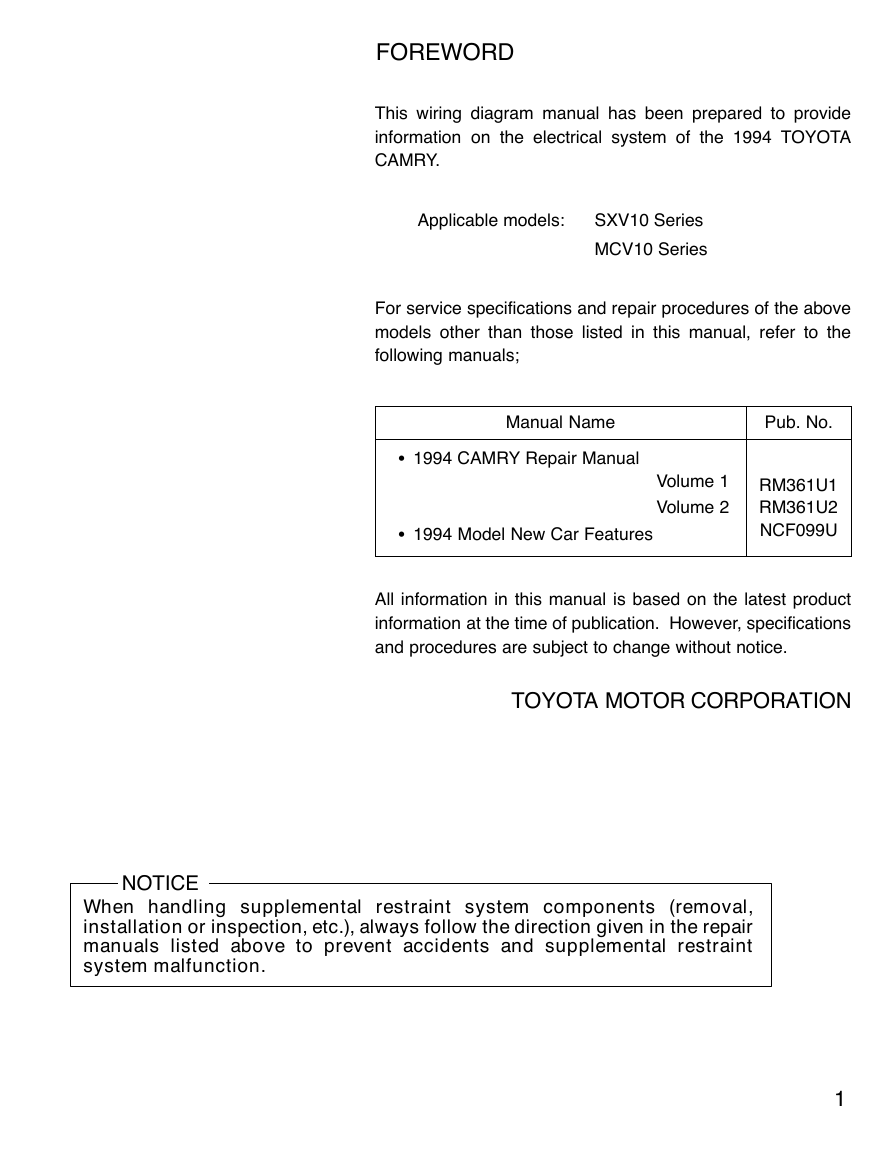

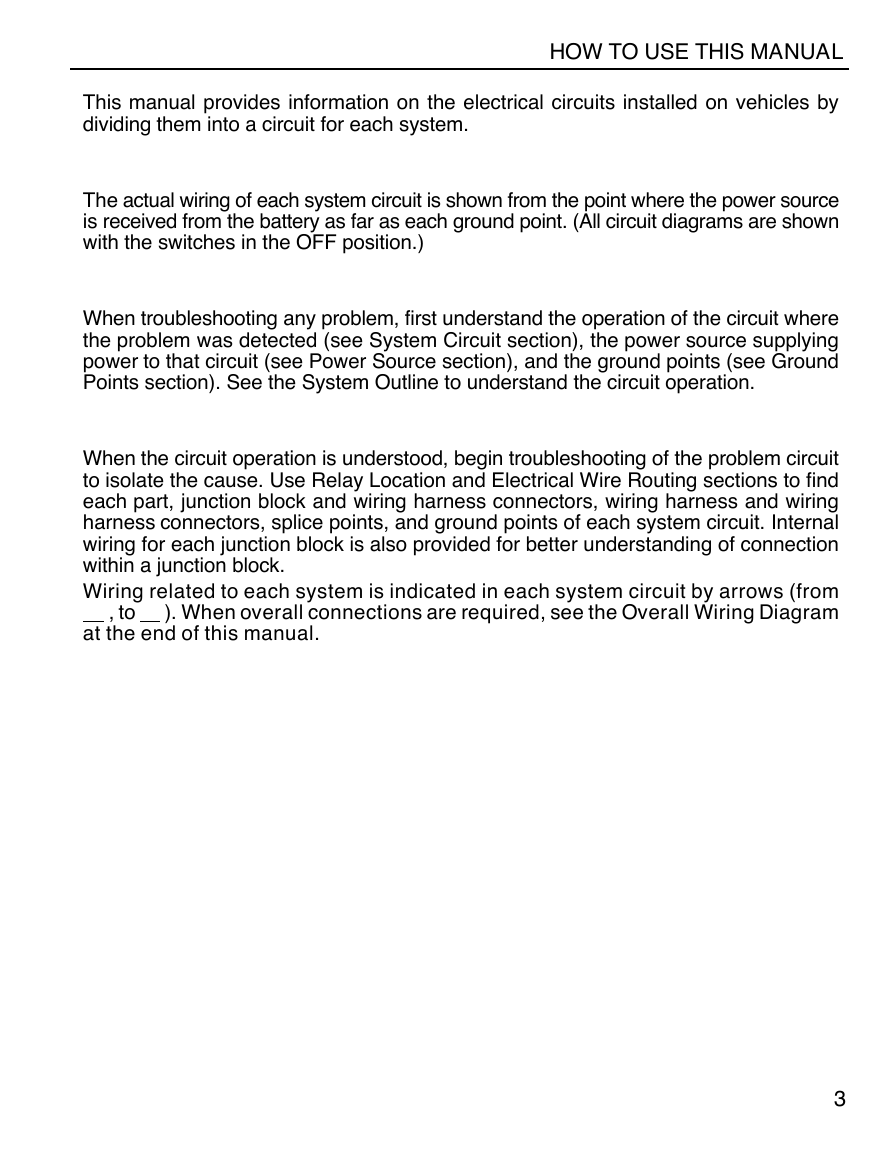
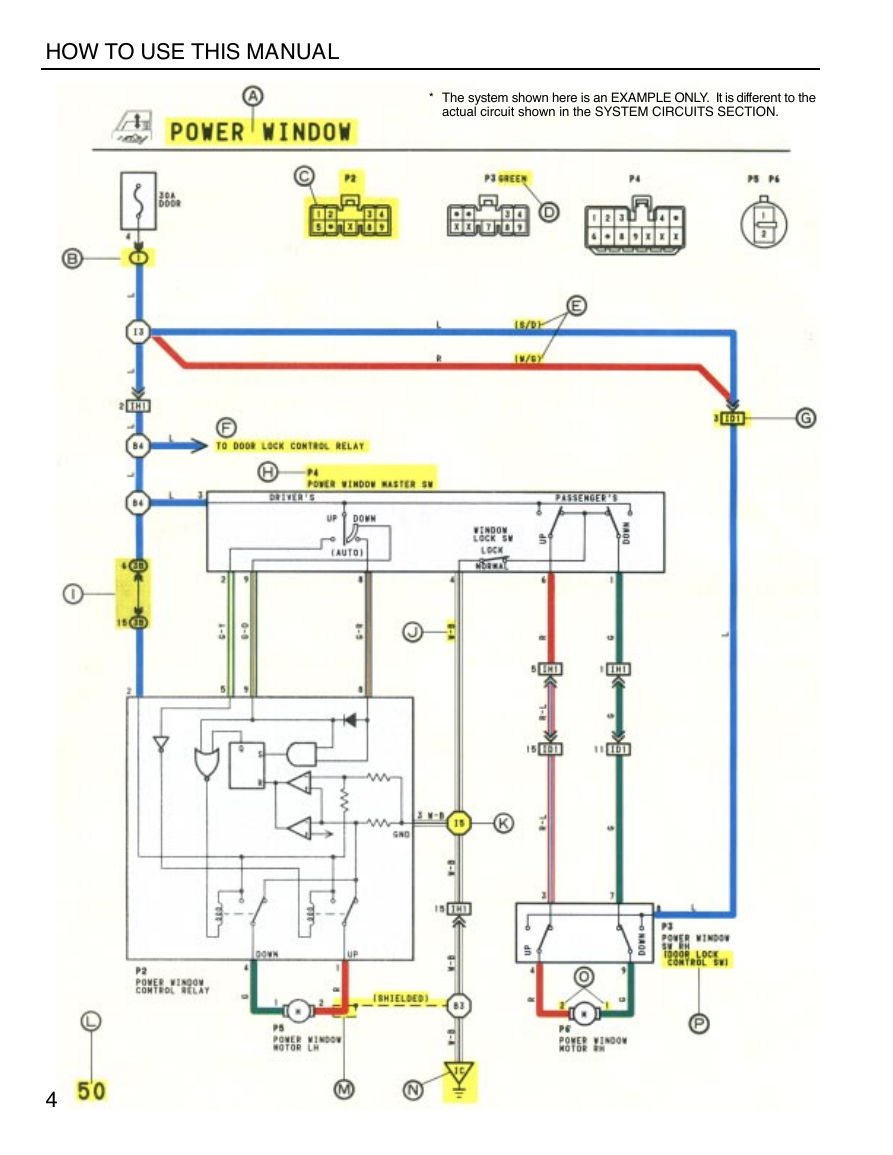
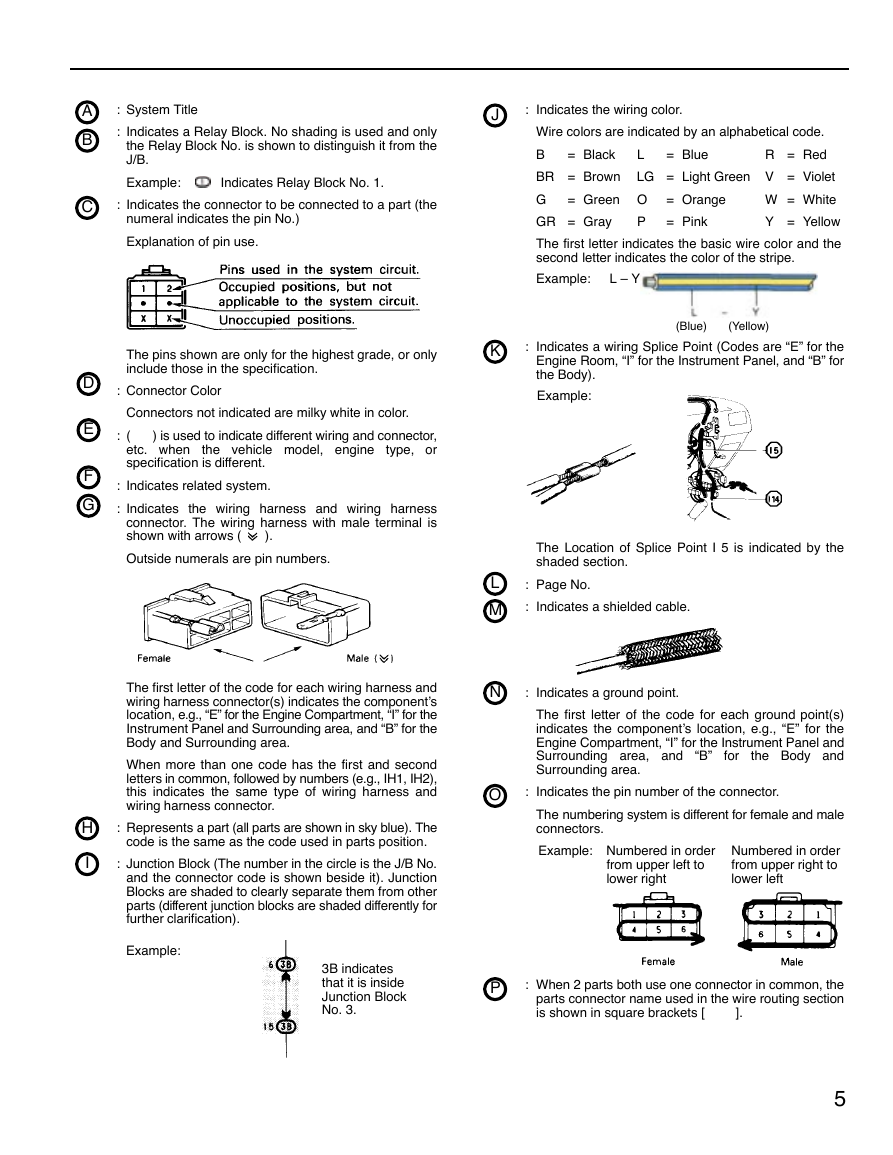
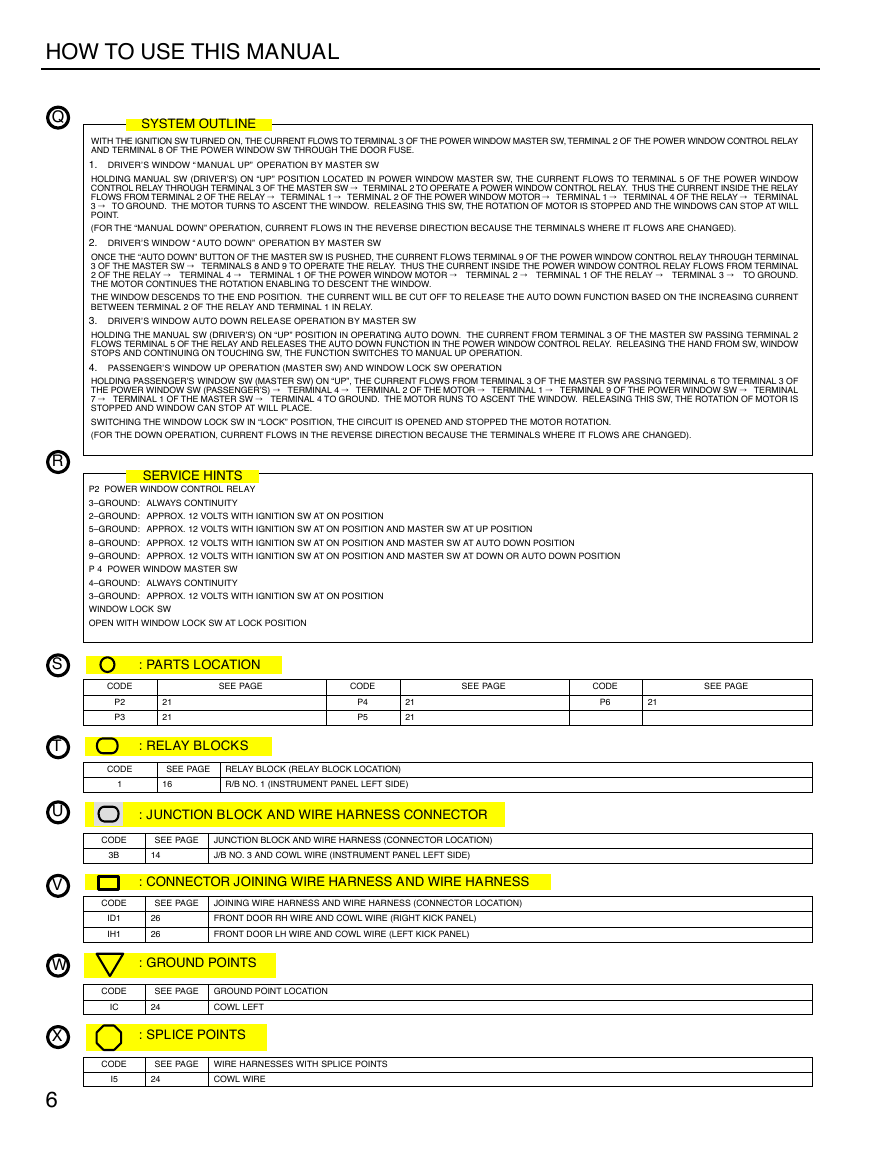
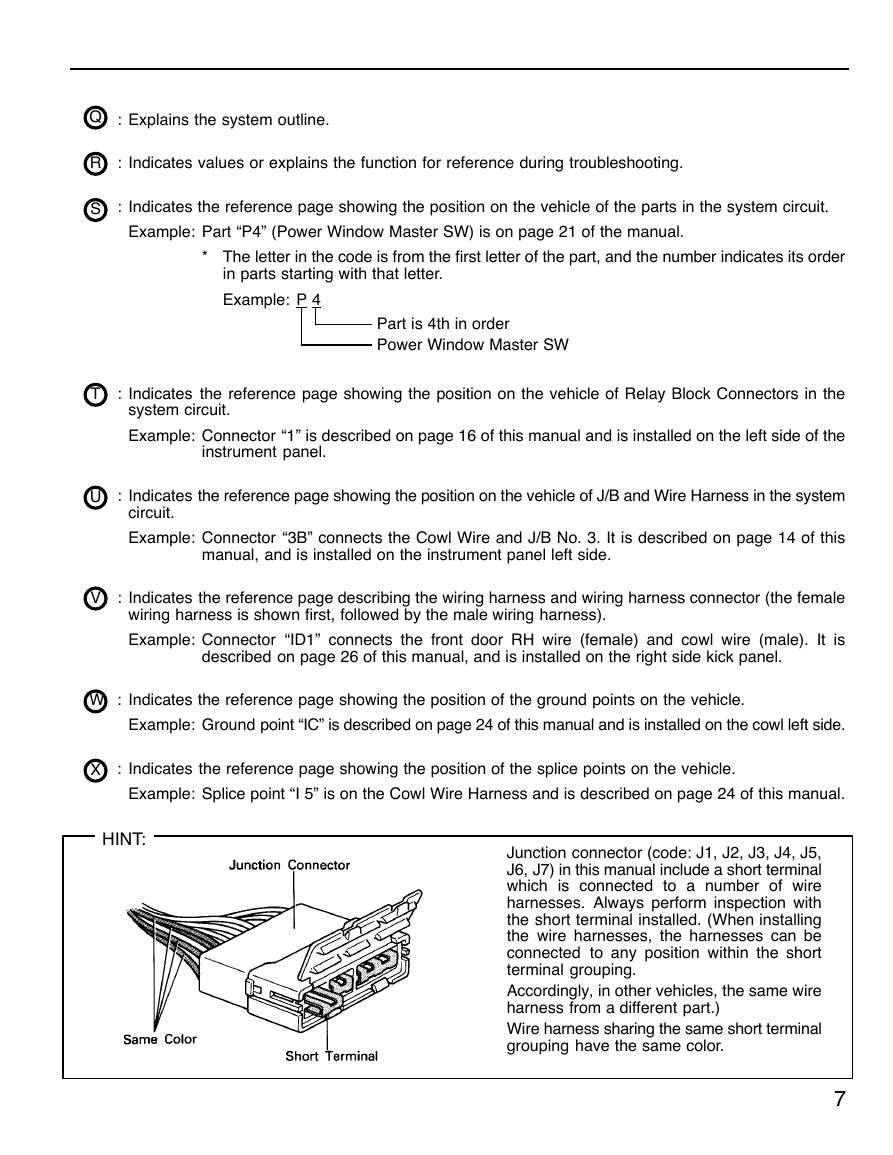
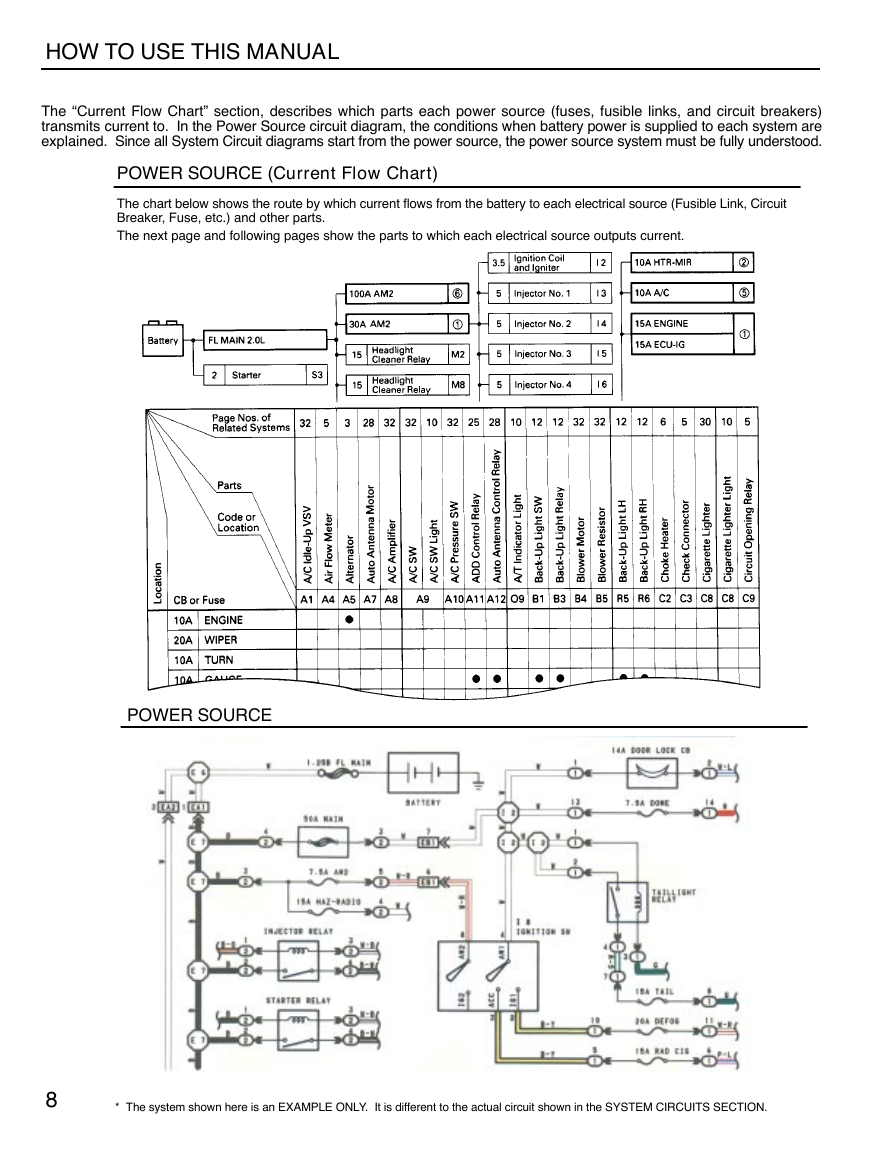








 2023年江西萍乡中考道德与法治真题及答案.doc
2023年江西萍乡中考道德与法治真题及答案.doc 2012年重庆南川中考生物真题及答案.doc
2012年重庆南川中考生物真题及答案.doc 2013年江西师范大学地理学综合及文艺理论基础考研真题.doc
2013年江西师范大学地理学综合及文艺理论基础考研真题.doc 2020年四川甘孜小升初语文真题及答案I卷.doc
2020年四川甘孜小升初语文真题及答案I卷.doc 2020年注册岩土工程师专业基础考试真题及答案.doc
2020年注册岩土工程师专业基础考试真题及答案.doc 2023-2024学年福建省厦门市九年级上学期数学月考试题及答案.doc
2023-2024学年福建省厦门市九年级上学期数学月考试题及答案.doc 2021-2022学年辽宁省沈阳市大东区九年级上学期语文期末试题及答案.doc
2021-2022学年辽宁省沈阳市大东区九年级上学期语文期末试题及答案.doc 2022-2023学年北京东城区初三第一学期物理期末试卷及答案.doc
2022-2023学年北京东城区初三第一学期物理期末试卷及答案.doc 2018上半年江西教师资格初中地理学科知识与教学能力真题及答案.doc
2018上半年江西教师资格初中地理学科知识与教学能力真题及答案.doc 2012年河北国家公务员申论考试真题及答案-省级.doc
2012年河北国家公务员申论考试真题及答案-省级.doc 2020-2021学年江苏省扬州市江都区邵樊片九年级上学期数学第一次质量检测试题及答案.doc
2020-2021学年江苏省扬州市江都区邵樊片九年级上学期数学第一次质量检测试题及答案.doc 2022下半年黑龙江教师资格证中学综合素质真题及答案.doc
2022下半年黑龙江教师资格证中学综合素质真题及答案.doc